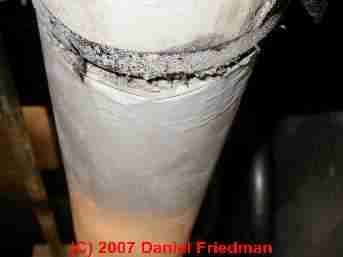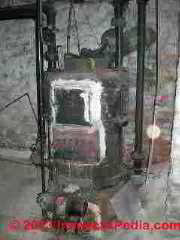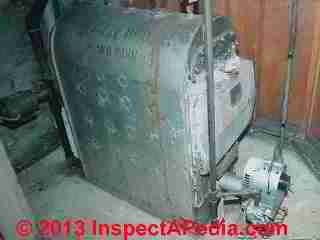 Hardcast Asbestos Insulation on Heating Boilers
Hardcast Asbestos Insulation on Heating Boilers
Asbestos insulation on heating equipment
- POST a QUESTION or COMMENT about removal of asbestos-containing pipe insulation: identification, encapsulation, or removal
Asbestos insulation on heating boilers:
Here we illustrate and discuss the handling of asbestos coatings used to insulate hot water (hydronic) or steam heating boilers.
Our photos provide examples of asbestos insulation used on hydronic or steam heating boilers and help in recognizing this asbestos insulating material where it was widely-used.
We use the term "hardcast" asbestos to refer to an asbestos paste or "plaster" that was typically applied in a layer of about 1" or greater, used to completely or partially coat old hot water or steam boilers and used on heat distribution piping at elbows or valves. Our page top photo shows original asbestos insulation coating a coal fired heating boiler that was later converted to oil fuel.
InspectAPedia tolerates no conflicts of interest. We have no relationship with advertisers, products, or services discussed at this website.
- Daniel Friedman, Publisher/Editor/Author - See WHO ARE WE?
Asbestos Boiler Insulation Photo Examples & Commentary

Asbestos-Insluated Boiler Remediation Strategy: Cleaning vs Replacement
This asbestos-insulated boiler, a second view of the page top heater, is covered with hardcast asbestos insulation in good condition.
But work on the boiler may require disturbing the insulating material, presenting a risk of asbestos exposure. In our experience (DF) the cost of employing a professional asbestos abatement firm to remove the asbestos insulation from this heater, considering the added costs for containment and asbestos waste disposal may be so high that the building owner should instead consider a complete boiler replacement.
The boiler replacement strategy still involves asbestos removal and disposal costs, but because the entire boiler can usually be removed intact, the amount of asbestos distrubance, the asbestos contamintion risk to the building, and the total project costs are likely to be much less than the cost to remove, clean, and re-seal the old boiler.
After adding consideration of the operating efficiency and cost of a coal-burning heaing boiler converted to oil fuel in comparison with the operating efficiency of a new oil or gas fired heater the prospect of a boiler swap-out may be still more appealing.
Above our photograph shows another antique (and converted fuel) oil fired heating boiler covered with asbestos insulation. Even opening and closing the upper fire door for annual boiler cleaning risks disturbing the asbestos insulation.
Just above the photograph shows a similar boiler that has had its asbestos jacket removed. Notice that this boiler is fired by an older low-speed (1725 rpm) oil burner - a system likely to be operating at a lower efficiency than a new modern boiler with a high speed (3450 rpm) burner.
The two heating boilers shown above also have had their insulation removed.
But at left we are not sure that the job was performed by a professional. An expert asbestos remediator will set up dust containment and negative air pressure in the work area to protect the building from cross-contamination by asbestos dust. Workers, wearing appropriate protective gear wet and remove the asbestos insulating material, properly bagging it for disposal by an approved asbestos waste hauler.
When asbestos has been removed from the boiler as well as any piping or other asbestos applications in the building, the exposed surfaces are cleaned and sealed, typically with a spray paint coating suitable for high temperature applications.
Watch out: If we find scraps of asbestos paste or lagging remaining in place on the boiler or heating piping we suspect that an amateur asbestos abatement job has been performed.
See ASBESTOS REMOVAL, Amateur
The risk is that inexpert workers caused asbestos dust cross-contamination in the building. In such cases, additional inspection, testing, and possibly further professional cleaning (typically by damp wiping and HEPA vacuuming of the affected areas and surfaces) are likely to be needed.
Asbestos Insulation Found on Hot Water Heating or Steam Heating Pipes
 Asbestos also was very widely used on hot water pipes connected to heating boilers, as we illustrate at left.
Asbestos also was very widely used on hot water pipes connected to heating boilers, as we illustrate at left.
We discuss this insulating material separately
at ASBESTOS PIPE-INSULATION
Also
see ASBESTOS DUCTS, HVAC a field identification guide to
visual detection of asbestos in and on heating and cooling system ducts and flue vents.
Asbestos pipe insulation materials like the insulation shown at page top should have been removed during asbestos abatement, and so form an indication of amateur workmanship, raising the question of asbestos particle contamination in other building areas.
...
Reader Comments, Questions & Answers About The Article Above
Below you will find questions and answers previously posted on this page at its page bottom reader comment box.
Reader Q&A - also see RECOMMENDED ARTICLES & FAQs
Question: I have about 30' of old hot water radiator heat piping with asbestos insulation ... what is the best method for removal ..
I have about 30' of old hot water radiator heat piping with asbestos insulation like that shown at the top of this page.
Need to remove insulation and then piping. Insulation appears to be wrapped in a cloth wrapping (more asbestos?). Is the insulation very friable? Besides using all proper PPE, isolation and clean-up described in your other sections, what is best method for removal of this asbestos insulation? - Tom
Reply: Characteristics of a Professional Asbestos Removal Job vs an Amateur Asbestos Removal Project
Tom, the corrugated-paper like asbestos pipe insulation we show at page top is quite soft and friable; the cloth wrapping its exterior is usually cotton or linen that has been painted and is not itself an asbestos material. I'd call a licensed asbestos removal company for this project.
In many jurisdictions you may be legally permitted to remove asbestos but the disposal of the asbestos containing material (ACM) waste must comply with local or state hazardous waste disposal regulations. See our page bottom ARTICLE INDEX article link:
ASBESTOS MATERIAL REGULATIONS
The difference between an amateur asbestos removal and a professional job is also that the pros can be expected to take the the steps we list below. You could follow these and the more detailed procedures for asbestos cleanup in the US EPA regulations and documents in our references, but the risks are:
ASBESTOS REMOVAL, Amateur, Incomplete health hazards for the worker(s) and a risk of contaminating the building with asbestos, leading to a still more-costly cleanup. Here is a general description of a professional asbestos cleanup procedure:
- comply with state or local asbestos abatement regulations
- set up containment where necessary to assure no dust contamination into other building areas
- probably wet the material to minimize dust spread
(see ASBESTOS REMOVAL, WETTING GUIDELINES) - carefully cut the cloth wrapping and remove the pipe insulation sections intact to minimize debris production
- remove asbestos paste/plaster that may have been used on pipe elbows
- wash and clean off asbestos that otherwise remains stuck to the now-exposed pipe surfaces
- possibly paint or seal all of the cleaned pipe with a paint sealant to assure no stray particles of asbestos remain available to become airborne
- properly dispose of the material
- give you documentation of a professional job (receipts by a licensed removal company) that avoid a possible real estate resale issue later on
- for large asbestos abatement/cleanup/removal projects where it's required by regulation or cost-justified, an independent expert will conduct testing before, in some cases during, and after the asbestos cleanup to assure that the dust from the cleanup project has been properly controlled and to assure as well that the cleanup is complete.
What is the Typical Cost of Asbestos Pipe Insulation Removal - per linear foot
Because we are past the peak of consumer fear about asbestos contamination and because the procedures, regulations, licensing have become well known, removal prices for a job like the one you describe should be manageable.
Current (2011) costs per foot to remove asbestos pipe insulation range from around $12. to $25. per foot on larger jobs, and $40. to $65. per foot on a small job. Those per foot costs tend to be less on a larger asbestos abatement project than on a smaller one because of the overhead of coming to the job, setting up containment, etc.
Does the Asbestos Pipe Insulation Actually Have to Be Removed?
If the asbestos pipe insulation is in good condition (not falling off, damaged, making a mess) and especially if it's not in an area where it is likely to be disturbed, you have the option of leaving it in place, perhaps coating it with an encapsulant. The cost of this approach is less than asbestos pipe insulation removal, and the total release of asbestos particles in the building is also less.
Of course plumbing and heating repairs or changes may make it necessary to disturb asbestos-insulated piping, in which case the material needs to be removed and disposed-of.
Asbestos site inspection fees
Typically you'll get a quote based on the number of linear feet of asbestos-insulated pipe to be cleaned, possibly such a quote can be obtained just by telephone, with of course the proviso that on seeing the site and a need for other measures that quote is "subject to site inspection" . If an onsite survey is required to plan the asbestos cleanup, some contractors charge around $300. for that service, and may for give that fee if they are then hired to conduct the cleanup.
Asbestos Waste Disposal Fees
We find this cost varies widely from being included in the cleanup per foot cost, to low fees for in-ground burial where permitted, to a cost per bag or pound to have the asbestos containing waste material double bagged and hauled to an approved dumping site by a licensed hazmat waste hauler.
Other asbestos cleanup costs
Other costs on larger asbestos abatement jobs typically include fees to run an air scrubber - figure $100./day - and the fees paid to a qualified expert for asbestos tests performed at the site before, during, and after the cleanup. For small residential asbestos cleanup jobs such as yours, onsite airborne asbestos monitoring is not performed.
Keep in mind that an amateur asbestos removal that contaminates the building is likely to result in a far greater subsequent cost to inspect, test, and clean the building of scattered asbestos dust and debris. During the peak asbestos scare I inspected a home for a buyer and observed extensive asbestos-insulated heating piping in the basement.
The owner decided he'd do the abatement himself. His wife later told me that "... he had white powdery stuff tracked literally all through the first floor of our home and even upstairs at times ...". In short, he made a horrible mess. The real estate sale stopped dead while the owners had to hire experts to then come and clean the entire home by wiping and HEPA vacuuming everything. It would have been less costly to have done the cleanup right the first time.
...
Continue reading at ASBESTOS in POOR CONDITION or select a topic from the closely-related articles below, or see the complete ARTICLE INDEX.
Or see these
Recommended Articles
Suggested citation for this web page
ASBESTOS BOILER INSULATION at InspectApedia.com - online encyclopedia of building & environmental inspection, testing, diagnosis, repair, & problem prevention advice.
Or see this
INDEX to RELATED ARTICLES: ARTICLE INDEX to ASBESTOS HAZARDS
Or use the SEARCH BOX found below to Ask a Question or Search InspectApedia
Ask a Question or Search InspectApedia
Try the search box just below, or if you prefer, post a question or comment in the Comments box below and we will respond promptly.
Search the InspectApedia website
Note: appearance of your Comment below may be delayed: if your comment contains an image, photograph, web link, or text that looks to the software as if it might be a web link, your posting will appear after it has been approved by a moderator. Apologies for the delay.
Only one image can be added per comment but you can post as many comments, and therefore images, as you like.
You will not receive a notification when a response to your question has been posted.
Please bookmark this page to make it easy for you to check back for our response.
IF above you see "Comment Form is loading comments..." then COMMENT BOX - countable.ca / bawkbox.com IS NOT WORKING.
In any case you are welcome to send an email directly to us at InspectApedia.com at editor@inspectApedia.com
We'll reply to you directly. Please help us help you by noting, in your email, the URL of the InspectApedia page where you wanted to comment.
Citations & References
In addition to any citations in the article above, a full list is available on request.
- 3/07: thanks to Gary Randolph, Ounce of Prevention Home Inspection, LLC Buffalo, NY, for attentive reading and editing suggestions. Mr. Randolph can be reached in Buffalo, NY, at (716) 636-3865 or email: gary@ouncehome.com
- Asbestos Identification, Walter C.McCrone, McCrone Research Institute, Chicago, IL.1987 ISBN 0-904962-11-3. Dr. McCrone literally "wrote the book" on asbestos identification procedures which formed the basis for current work by asbestos identification laboratories.
- Stanton, .F., et al., National Bureau of Standards Special Publication 506: 143-151
- Pott, F., Staub-Reinhalf Luft 38, 486-490 (1978) cited by McCrone
- ASBESTOS IN YOUR HOME U.S. EPA, Exposure Evaluation Division, Office of Toxic Substances, Office of Pesticides and Toxic Substances, U.S. Environmental Protection Agency, Washington,D.C. 20460
- "Handling Asbestos-Containing roofing material - an update", Carl Good, NRCA Associate Executive Director, Professional Roofing, February 1992, p. 38-43
- EPA Guidance for Controlling Asbestos-Containing Materials in buildings, NIAST, National Institute on Abatement Sciences & Technology, [republishing EPA public documents] 1985 ed., Exposure Evaluation Division, Office of Toxic Substances, Office of Pesticides and Toxic Substances, U.S. Environmental Protection Agency, Washington,D.C. 20460
- In addition to citations & references found in this article, see the research citations given at the end of the related articles found at our suggested
CONTINUE READING or RECOMMENDED ARTICLES.
- Carson, Dunlop & Associates Ltd., 120 Carlton Street Suite 407, Toronto ON M5A 4K2. Tel: (416) 964-9415 1-800-268-7070 Email: info@carsondunlop.com. Alan Carson is a past president of ASHI, the American Society of Home Inspectors.
Thanks to Alan Carson and Bob Dunlop, for permission for InspectAPedia to use text excerpts from The HOME REFERENCE BOOK - the Encyclopedia of Homes and to use illustrations from The ILLUSTRATED HOME .
Carson Dunlop Associates provides extensive home inspection education and report writing material. In gratitude we provide links to tsome Carson Dunlop Associates products and services.





